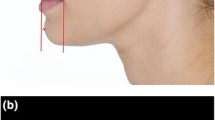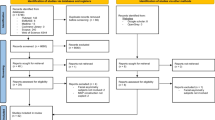Abstract
Background
Understanding the degree of facial mobility upon postural changes is of great clinical relevance especially if facial assessment, facial measurements and/or facial markings are done in an upright position, but facial procedures are performed in a supine position.
Objective
The objective of this study is to investigate regional facial skin displacement and facial volume changes in individuals between upright and supine positions.
Methods
This multi-center study analyzed a total of 175 study participants with a mean age of 35.0 (10.2) years and a mean body mass index of 24.71 (3.5) kg/m2. 3D surface scanning technology with automated registration and alignment was utilized, and multivariate analyses were performed with adjustment for age, gender, body mass index, facial skin sagging and laxity.
Results
The medial face displaced less than the lateral face in both cranial (0.88 mm) and in lateral (0.76 mm) directions, and the lower face displaced more than the middle face in both cranial (1.17 mm) and lateral directions (1.37 mm). Additionally, the medial face lost, on average, 3.00cc whereas the lateral face increased by 5.86cc in volume; the middle face increased by 2.95cc, whereas the lower face decreased by 0.98cc in volume. All p < 0.001.
Conclusion
Practitioners should be mindful that there is a statistically significant change in facial soft tissues between the upright and supine positions and that the magnitude of the change does not necessarily reflect on the aging process alone but is a multi-factorial process which should be individualized for each patient’s needs.
Level of Evidence IV
This journal requires that authors assign a level of evidence to each article. For a full description of these Evidence-Based Medicine ratings, please refer to the Table of Contents or the online Instructions to Authors www.springer.com/00266.





Similar content being viewed by others
References
Cotofana S, Fratila A, Schenck TL, Redka-Swoboda W, Zilinsky I, Pavicic T (2016) The anatomy of the aging face: a review. Facial Plast Surg 32(3):253–260. https://doi.org/10.1055/s-0036-1582234
Kligman LH (1989) Photoaging. Manifestations, prevention, and treatment. Clin Geriatr Med. https://doi.org/10.1016/s0749-0690(18)30708-0
Kligman AM (1969) Early destructive effect of sunlight on human skin. JAMA J Am Med Assoc. https://doi.org/10.1001/jama.1969.03160390039008
Mancini M, Lena AM, Saintigny G et al (2014) MicroRNAs in human skin ageing. Ageing Res Rev 17:9
Zhang S, Duan E (2018) Fighting against skin aging: the way from bench to bedside. Cell Transplant. https://doi.org/10.1177/0963689717725755
Schenck TL, Koban KC, Schlattau A et al (2018) The functional anatomy of the superficial fat compartments of the face: a detailed imaging study. Plast Reconstr Surg 141(6):1351–1359. https://doi.org/10.1097/PRS.0000000000004364
Cotofana S, Gotkin RH, Frank K et al (2019) The functional anatomy of the deep facial fat compartments. Plast Reconstr Surg 143(1):53–63. https://doi.org/10.1097/PRS.0000000000005080
Sipilä S, Törmäkangas T, Sillanpää E et al (2020) Muscle and bone mass in middle-aged women: role of menopausal status and physical activity. J Cachexia Sarcopenia Muscle. https://doi.org/10.1002/jcsm.12547
Marzetti E, Calvani R, Tosato M et al (2017) Sarcopenia: an overview. Aging Clin Exp Res 29(1):11–17. https://doi.org/10.1007/s40520-016-0704-5
Brandt MG, Hassa A, Roth K, Wehrli B, Moore CC (2012) Biomechanical properties of the facial retaining ligaments. Arch Facial Plast Surg 14(4):289–294. https://doi.org/10.1001/archfacial.2011.1533
Cotofana S, Gotkin RH, Ascher B et al (2018) Calvarial volume loss and facial aging: a computed tomographic (CT)-based study. Aesthetic Surg J 38(10):1043–1051. https://doi.org/10.1093/asj/sjy096
Frank K, Gotkin RH, Pavicic T et al (2018) Age and gender differences of the frontal bone: a computed tomographic (CT)-based study. Aesthetic Surg J. https://doi.org/10.1093/asj/sjy270
Cotofana S, Gotkin RH, Morozov SP et al (2018) The relationship between bone remodeling and the clockwise rotation of the facial skelton—a computed tomography imaging based evaluation. Plast Reconstr Surg. https://doi.org/10.1097/PRS.0000000000004976
Bulut O, Jessica Liu CY, Koca F, Wilkinson C (2017) Comparison of three-dimensional facial morphology between upright and supine positions employing three-dimensional scanner from live subjects. Leg Med 27(February):32–37. https://doi.org/10.1016/j.legalmed.2017.06.002
Hoogeveen RC, Sanderink GCH, Berkhout WER (2013) Effect of head position on cephalometric evaluation of the soft-tissue facial profile. Dentomaxillofac Radiol. https://doi.org/10.1259/dmfr.20120423
Iblher N, Gladilin E, Stark BG (2013) Soft-tissue mobility of the lower face depending on positional changes and age: a three-dimensional morphometric surface analysis. Plast Reconstr Surg 131(2):372–381. https://doi.org/10.1097/PRS.0b013e318278d67c
Mally P, Czyz CN, Wulc AE (2014) The role of gravity in periorbital and midfacial aging. Aesthetic Surg J 34(6):809–822. https://doi.org/10.1177/1090820X14535077
Marin F, Ben Mansour K, Demeter F, Frey P (2015) Displacement of facial soft tissues in upright versus supine positions. Comput Methods Biomech Biomed Engin 18(October):1988–1989. https://doi.org/10.1080/10255842.2015.1069590
Munn L, Stephan CN (2018) Changes in face topography from supine-to-upright position—and soft tissue correction values for craniofacial identification. Forensic Sci Int 289:40–50. https://doi.org/10.1016/j.forsciint.2018.05.016
Ozsoy U, Sekerci R, Ogut E (2015) Effect of sitting, standing, and supine body positions on facial soft tissue: detailed 3D analysis. Int J Oral Maxillofac Surg 44(10):1309–1316. https://doi.org/10.1016/j.ijom.2015.06.005
Alexiades-Armenakas M, Rosenberg D, Renton B, Dover J, Arndt K (2010) Blinded, randomized, quantitative grading comparison of minimally invasive, fractional radiofrequency and surgical face-lift to treat skin laxity. Arch Dermatol 146(4):396–405. https://doi.org/10.1001/archdermatol.2010.24
Narins RS, Carruthers J, Flynn TC et al (2012) Validated assessment scales for the lower face. Dermatol Surg 38(2 PART 2):333–342. https://doi.org/10.1111/j.1524-4725.2011.02247.x
Cotofana S, Freytag DL, Frank K et al (2020) the bi-directional movement of the frontalis muscle - introducing the line of convergence and its potential clinical relevance. Plast Reconstr Surg 145(5):1155–1162. https://doi.org/10.1097/PRS.0000000000006756
Frank K, Freytag DL, Schenck TL et al (2019) Relationship between forehead motion and the shape of forehead lines—a 3D skin displacement vector analysis. J Cosmet Dermatol. https://doi.org/10.1111/jocd.13065
Liew S, Frank K, Kolenda J, Braun M, Cotofana S (2020) A comparison of single versus dual—vector technique using facial suspension threads—a split-face cadaveric study. Dermatol Surg 46:1721
Braun M, Frank K, Freytag DL et al (2020) The influence of the insertion angle on middle and lower face tissue-mechanics when treating the nasolabial folds with facial suspension threads—an experimental split-face cadaveric study. Facial Plast Surg 23:1–8
Cotofana S, Gotkin RH, Frank K, Lachman N, Schenck TL (2019) Anatomy behind the facial overfilled syndrome: the transverse facial septum. Dermatol Surg. https://doi.org/10.1097/DSS.0000000000002236
Casabona G, Bernardini FP, Skippen B et al (2020) How to best utilize the line of ligaments and the surface volume coefficient in facial soft tissue filler injections. J Cosmet Dermatol 19(2):303–311. https://doi.org/10.1111/jocd.13245
Casabona G, Frank K, Koban KC et al (2019) Lifting vs volumizing-The difference in facial minimally invasive procedures when respecting the line of ligaments. J Cosmet Dermatol. https://doi.org/10.1111/jocd.13089
Cotofana S, Lachman N (2019) Anatomy of the facial fat compartments and their relevance in aesthetic surgery. JDDG J der Dtsch Dermatol Ges 17(4):399–413. https://doi.org/10.1111/ddg.13737
Stuzin JM, Baker TJ, Gordon HL (1992) The relationship of the superficial and deep facial fascias: relevance to rhytidectomy and aging. Plast Reconstr Surg 89(3):441–449 (discussion 450-1)
Muzaffar AR, Mendelson BC, Adams WP (2002) Surgical anatomy of the ligamentous attachments of the lower lid and lateral canthus. Plast Reconstr Surg 110(3):873–884 (discussion 897-911)
Ramesh S, Johnson P, Sarcu D, Wulc AE (2021) Gravity in midfacial aging: a 3-dimensional study. Aesthetic Surg J 41(2):143–151. https://doi.org/10.1093/asj/sjaa021
Funding
The authors received no financial support for the research, authorship, and publication of this article.
Author information
Authors and Affiliations
Corresponding author
Ethics declarations
Conflict of interest
The authors declare that they have no conflicts of interest to disclose.
Ethical Approval
The study was approved by the ethics committee of University of Belgrade, Serbia, under the approval number: 9V08J20SR0352/2020. The study was conducted in accordance with regional laws and good clinical practice.
Informed Consent
Study participants were informed about the aims and the methodology of this study and provided written informed consent for the use of their personal and their 3D facial imaging data for research purposes.
Additional information
Publisher's Note
Springer Nature remains neutral with regard to jurisdictional claims in published maps and institutional affiliations.
Rights and permissions
About this article
Cite this article
Hernandez, C.A., Alfertshofer, M., Frank, K. et al. Quantitative Mobility Analysis of the Face and its Relevance for Surgical and Non-surgical Aesthetic Facial Procedures. Aesth Plast Surg 46, 2237–2245 (2022). https://doi.org/10.1007/s00266-022-02921-8
Received:
Accepted:
Published:
Issue Date:
DOI: https://doi.org/10.1007/s00266-022-02921-8




